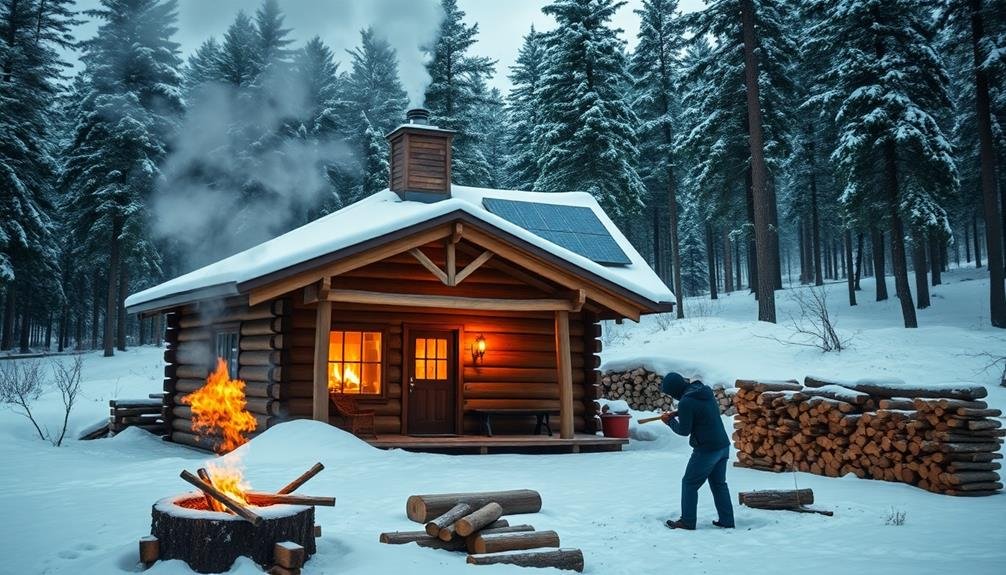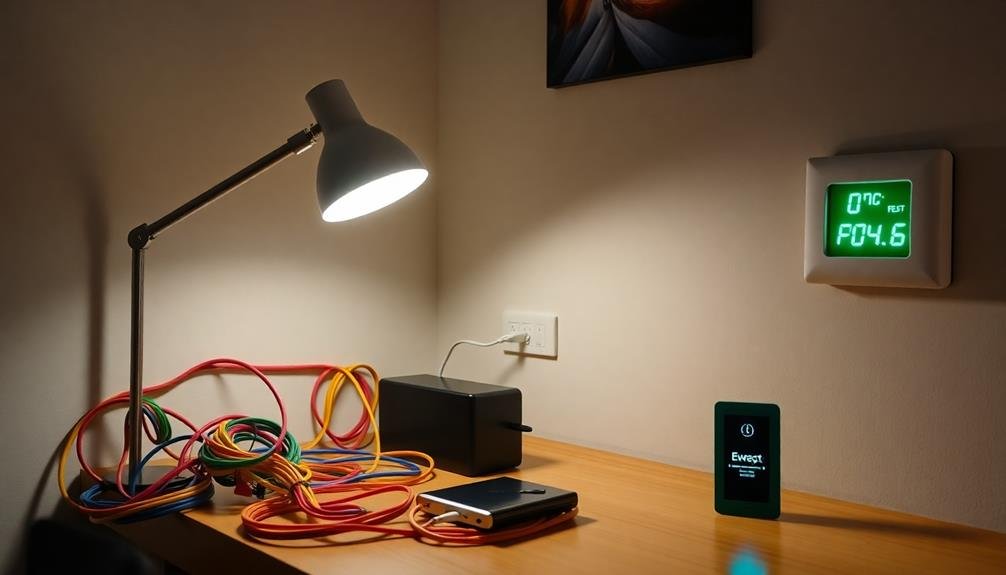When seeking off-grid biomass heating solutions for your home, you've got several excellent options. Wood-burning stoves offer reliability and efficiency, while pellet stoves provide automated fuel feeding. Masonry heaters combine efficient heat retention with thermal mass, and rocket mass heaters deliver exceptional fuel efficiency. Biomass boilers burn various organic materials, and gasification systems convert solid biomass into combustible gas. For a unique approach, compost heating methods utilize decomposition to generate heat. Each solution has its own advantages, and understanding their specific features will help you choose the best fit for your off-grid heating needs.
Wood-Burning Stoves

Serving as a cornerstone of off-grid heating, wood-burning stoves offer a reliable and efficient solution for those seeking energy independence. These stoves come in various sizes and designs, allowing you to choose one that fits your space and heating needs.
Modern wood stoves are engineered for better combustion, resulting in higher efficiency and lower emissions compared to their older counterparts.
When selecting a wood-burning stove, consider factors like heat output, burn time, and ease of use. Look for models with EPA certification to guarantee they meet current environmental standards.
You'll need to invest in a proper chimney system and follow local building codes for safe installation.
To maximize efficiency, use seasoned hardwoods and maintain your stove regularly. You'll need to clean the ash, inspect the gaskets, and sweep the chimney periodically.
While wood stoves require more hands-on attention than other heating methods, they provide a warm, inviting atmosphere and can operate independently of the power grid.
Remember to store an adequate supply of firewood and keep it dry to guarantee you're prepared for extended periods of off-grid living.
Pellet Stoves
Pellet stoves offer you an efficient way to heat your off-grid home using compressed biomass fuel.
You'll appreciate their automated fuel feeding system, which maintains consistent heat output without frequent manual intervention.
These stoves also require less maintenance than traditional wood-burning options, making them a convenient choice for your sustainable heating needs.
Efficient Heat Production
The cornerstone of efficient biomass heating lies in pellet stoves. These innovative devices offer superior heat production compared to traditional wood stoves. You'll find that pellet stoves burn compressed wood or biomass pellets, resulting in a more consistent and controllable heat output.
To maximize efficiency, you should:
- Choose a stove sized appropriately for your space
- Guarantee proper installation and regular maintenance
- Use high-quality pellets for peak performance
Here's a comparison of pellet stoves to other heating methods:
| Feature | Pellet Stoves | Wood Stoves | Gas Heaters | Electric Heaters |
|---|---|---|---|---|
| Fuel Cost | Low | Low | Medium | High |
| Efficiency | 70-83% | 60-80% | 80-95% | 100% |
| Maintenance | Medium | High | Low | Low |
| Environmental Impact | Low | Medium | Medium | Varies |
| Automation | High | Low | High | High |
You'll notice that pellet stoves offer a balance of efficiency, cost-effectiveness, and environmental friendliness. They're also easier to use than traditional wood stoves, with automatic fuel feeding and temperature controls. By choosing a pellet stove, you're opting for a reliable and efficient off-grid heating solution that can considerably reduce your energy costs and carbon footprint.
Automated Fuel Feeding
One of the most convenient features you'll find in pellet stoves is their automated fuel feeding system. This innovative mechanism eliminates the need for frequent manual loading, making pellet stoves a user-friendly option for off-grid heating. The system works by storing wood pellets in a hopper, which then feeds them into the combustion chamber at a controlled rate.
You'll appreciate how this automation maintains a consistent heat output and reduces the time you spend tending to your stove. Most pellet stoves can operate for 24-48 hours on a single hopper load, depending on the hopper size and heat setting. This extended burn time is particularly beneficial during cold nights or when you're away from home.
The automated feeding system also contributes to the stove's efficiency. By precisely controlling the fuel supply, it optimizes combustion and minimizes waste.
You'll find that this results in lower fuel consumption and reduced ash production compared to traditional wood stoves. Additionally, the consistent fuel feed helps maintain a steady temperature, enhancing your comfort and reducing temperature fluctuations in your living space.
Low Maintenance Requirements
Along with automated fuel feeding, you'll find that pellet stoves boast impressively low maintenance requirements.
Unlike traditional wood stoves, pellet stoves don't require constant attention or frequent cleaning. You'll only need to empty the ash pan once a week during regular use, and perform a thorough cleaning every 1-2 tons of pellets burned.
The combustion chamber and heat exchanger typically need cleaning just once or twice per heating season. You can easily remove and clean the burn pot weekly to prevent clinker buildup.
Most pellet stoves have self-cleaning features that reduce your workload even further.
Annual maintenance is straightforward and can often be done without professional help. This usually involves inspecting and cleaning the exhaust system, lubricating moving parts, and checking seals and gaskets.
The auger and fan motors are designed for long-term use and rarely need replacement.
Masonry Heaters

Masonry heaters offer you a unique combination of efficient heat retention and long-lasting thermal mass for your off-grid home.
You'll find these heaters can maintain warmth for hours after the fire has died down, thanks to their dense construction materials.
Whether you prefer a traditional or modern look, you can choose from versatile design options to match your home's aesthetic while benefiting from this eco-friendly heating solution.
Efficient Heat Retention
Among the most efficient heat retention systems for off-grid biomass heating, masonry heaters stand out as exceptional performers.
These ingenious devices can retain heat for up to 24 hours after a single firing, making them ideal for off-grid homes. They work by burning wood at high temperatures, storing the heat in their massive thermal mass, and then slowly releasing it throughout your living space.
You'll find that masonry heaters offer several advantages over traditional wood stoves:
- Higher efficiency, with up to 90% of the wood's energy converted to usable heat
- Cleaner burns, resulting in fewer emissions and less creosote buildup
- Even heat distribution throughout your home, eliminating cold spots
- Reduced fuel consumption, saving you time and money on wood gathering
To maximize the heat retention of your masonry heater, you'll want to verify it's properly sized for your space and strategically placed within your home.
You can also incorporate additional heat-storing elements, such as stone or brick walls, to further enhance its efficiency.
Long-Lasting Thermal Mass
Immerse yourself in the world of long-lasting thermal mass, and you'll discover why masonry heaters are the cornerstone of efficient off-grid biomass heating. These ingenious devices capture and store heat from a short, intense burn, releasing it slowly over many hours.
Masonry heaters are built with dense materials like stone, brick, or ceramic, which absorb heat during the burning process. Once the fire's out, the stored heat radiates into your living space for up to 24 hours. This means you'll only need to light a fire once or twice a day, even in cold climates.
You'll appreciate the even, comfortable heat these systems provide. Unlike traditional wood stoves that create hot and cold spots, masonry heaters distribute warmth uniformly throughout your home.
They're also highly efficient, converting up to 90% of the fuel's energy into usable heat.
While the initial investment is higher than other biomass options, you'll reap long-term benefits. Masonry heaters are durable, often lasting for decades with minimal maintenance.
They're also versatile, allowing you to incorporate features like baking ovens or heated benches into their design.
Versatile Design Options
Beyond their impressive thermal performance, masonry heaters offer a wide array of design possibilities to suit your aesthetic preferences and functional needs.
You'll find that these versatile heating systems can be customized to complement any architectural style, from rustic cabins to modern homes.
Masonry heaters can be built as freestanding units or integrated into existing walls. You've got the freedom to choose from various materials, including brick, stone, tile, or stucco, allowing you to create a unique focal point in your living space.
Some designs incorporate practical features like built-in benches, cookstoves, or even pizza ovens, maximizing functionality.
Here's what you can expect from masonry heater design options:
- Multiple firebox locations (front, side, or rear-loading)
- Various shapes and sizes (traditional, cylindrical, or custom forms)
- Decorative elements (carved stone, intricate brickwork, or mosaic tiles)
- Functional add-ons (bake ovens, water heating coils, or warm air ducts)
Don't forget that your masonry heater can also serve as a room divider or a stunning centerpiece.
With so many possibilities, you're sure to find a design that perfectly fits your off-grid home's heating needs and style preferences.
Rocket Mass Heaters
At the forefront of efficient off-grid heating systems, rocket mass heaters stand out as a revolutionary solution. These innovative devices combine principles of rocket stove combustion with thermal mass storage, offering exceptional fuel efficiency and long-lasting heat output.
You'll find that rocket mass heaters burn wood more completely than traditional stoves, reducing smoke emissions and maximizing heat production. The design typically includes a horizontal burn tunnel, heat riser, and a large thermal mass—often a cob bench or bed—which absorbs and slowly releases heat over time.
When you're considering a rocket mass heater, you'll appreciate its ability to maintain comfortable temperatures for hours after the fire has gone out. This feature makes it ideal for overnight heating in cold climates. You can expect to use notably less fuel compared to conventional wood stoves, potentially saving you time and resources.
Installation requires careful planning and often involves custom construction to integrate the heater into your living space. While DIY options exist, it's essential to understand local building codes and safety requirements before starting on a rocket mass heater project.
Biomass Boilers

Biomass boilers offer another efficient heating solution for off-grid living. These systems burn organic materials like wood pellets, chips, or logs to produce heat for your home. They're an excellent option if you have access to a steady supply of biomass fuel and want a more automated heating system compared to traditional wood stoves.
When considering a biomass boiler for your off-grid home, keep these key points in mind:
- Fuel storage: You'll need ample space to store your biomass fuel, whether it's wood pellets, chips, or logs.
- Automation: Many biomass boilers feature automatic fuel feeding systems, reducing the need for manual intervention.
- Efficiency: Modern biomass boilers can achieve efficiency ratings of up to 90%, maximizing heat output from your fuel.
- Maintenance: Regular cleaning and ash removal are necessary to keep your boiler running smoothly.
Biomass boilers can be integrated with existing heating systems, including radiators and underfloor heating. They're also compatible with thermal storage tanks, allowing you to store excess heat for later use.
While initial costs may be higher than traditional heating systems, the long-term savings on fuel costs and reduced environmental impact make biomass boilers an attractive option for off-grid living.
Gasification Systems
For those seeking an even more advanced biomass heating solution, gasification systems offer a highly efficient and clean-burning option. These systems work by converting solid biomass fuel into a combustible gas through a process called gasification.
This gas is then burned to produce heat, resulting in a more complete combustion and lower emissions compared to traditional biomass boilers.
You'll find that gasification systems can achieve efficiency rates of up to 90%, making them an excellent choice for off-grid heating. They're capable of using a variety of biomass fuels, including wood chips, pellets, and agricultural residues.
The generated gas can be used not only for heating but also for powering engines or turbines to produce electricity.
When considering a gasification system, you'll need to account for the higher initial cost and more complex installation process. However, the long-term benefits often outweigh these factors.
You'll enjoy lower fuel consumption, reduced ash production, and minimal maintenance requirements. Additionally, many modern gasification systems come with advanced control features, allowing you to optimize performance and monitor your system remotely.
Compost Heating Methods

While gasification systems offer high-tech solutions, you might be surprised to learn that nature's decomposition process can also provide heat for your off-grid home. Compost heating methods harness the energy released by microorganisms as they break down organic matter. This innovative approach can warm your living space and provide hot water, all while recycling waste materials.
To create an effective compost heating system, you'll need:
- A large, insulated container for the compost pile
- A mix of nitrogen-rich (green) and carbon-rich (brown) materials
- A network of water pipes or air ducts embedded in the pile
- A pump or fan to circulate the heated water or air
You'll start by layering your organic materials in the container, ensuring proper moisture and aeration. As the compost decomposes, it can reach temperatures of up to 150°F (65°C). The embedded pipes or ducts capture this heat, which you can then transfer to your home's heating system or water supply.
Regular monitoring and occasional turning of the pile will help maintain ideal temperatures. While compost heating requires more hands-on management than other biomass methods, it offers a sustainable way to recycle waste and heat your home simultaneously.
Frequently Asked Questions
How Do Off-Grid Biomass Heating Solutions Impact Local Air Quality?
Off-grid biomass heating can impact local air quality. You'll notice increased particulate matter and emissions in the area. It's important to use efficient systems and well-seasoned wood to minimize pollution and protect your neighborhood's air quality.
What Are the Maintenance Requirements for Biomass Heating Systems?
You'll need to regularly clean ash from the combustion chamber and flue. You should also inspect and maintain moving parts, check for wear, and schedule annual professional servicing. Don't forget to keep your fuel supply dry and well-stocked.
Can Biomass Heating Be Integrated With Existing Home Heating Systems?
Yes, you can integrate biomass heating with your existing system. You'll need a professional to install a biomass boiler or stove that connects to your current heating setup. It's often used alongside traditional systems for flexibility.
Are There Government Incentives Available for Installing Biomass Heating Solutions?
Yes, you'll find government incentives available for biomass heating installations. Check with your local energy office or visit the Database of State Incentives for Renewables & Efficiency (DSIRE) to discover specific programs in your area.
How Do Biomass Heating Costs Compare to Traditional Fossil Fuel Heating?
You'll find biomass heating costs are often lower than fossil fuel heating. While initial installation may be pricier, you'll save on fuel expenses over time. Biomass fuel prices are typically more stable, helping you budget better.
In Summary
You've now explored seven excellent off-grid biomass heating options for your home. Whether you're looking for traditional wood-burning stoves or innovative compost heating methods, there's a solution to fit your needs. Remember, each system has its pros and cons, so consider your specific requirements, budget, and local regulations. By choosing one of these eco-friendly heating solutions, you'll reduce your carbon footprint and potentially save money on energy costs. It's time to embrace sustainable warmth!





Leave a Reply